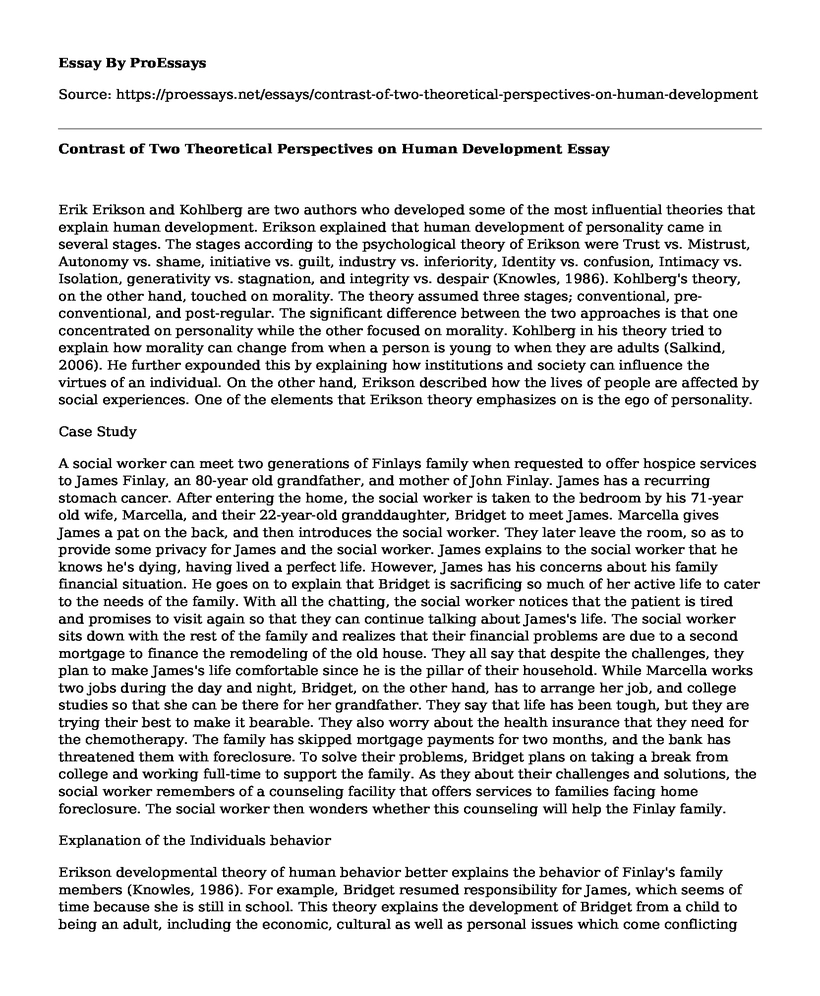Erik Erikson and Kohlberg are two authors who developed some of the most influential theories that explain human development. Erikson explained that human development of personality came in several stages. The stages according to the psychological theory of Erikson were Trust vs. Mistrust, Autonomy vs. shame, initiative vs. guilt, industry vs. inferiority, Identity vs. confusion, Intimacy vs. Isolation, generativity vs. stagnation, and integrity vs. despair (Knowles, 1986). Kohlberg's theory, on the other hand, touched on morality. The theory assumed three stages; conventional, pre-conventional, and post-regular. The significant difference between the two approaches is that one concentrated on personality while the other focused on morality. Kohlberg in his theory tried to explain how morality can change from when a person is young to when they are adults (Salkind, 2006). He further expounded this by explaining how institutions and society can influence the virtues of an individual. On the other hand, Erikson described how the lives of people are affected by social experiences. One of the elements that Erikson theory emphasizes on is the ego of personality.
Case Study
A social worker can meet two generations of Finlays family when requested to offer hospice services to James Finlay, an 80-year old grandfather, and mother of John Finlay. James has a recurring stomach cancer. After entering the home, the social worker is taken to the bedroom by his 71-year old wife, Marcella, and their 22-year-old granddaughter, Bridget to meet James. Marcella gives James a pat on the back, and then introduces the social worker. They later leave the room, so as to provide some privacy for James and the social worker. James explains to the social worker that he knows he's dying, having lived a perfect life. However, James has his concerns about his family financial situation. He goes on to explain that Bridget is sacrificing so much of her active life to cater to the needs of the family. With all the chatting, the social worker notices that the patient is tired and promises to visit again so that they can continue talking about James's life. The social worker sits down with the rest of the family and realizes that their financial problems are due to a second mortgage to finance the remodeling of the old house. They all say that despite the challenges, they plan to make James's life comfortable since he is the pillar of their household. While Marcella works two jobs during the day and night, Bridget, on the other hand, has to arrange her job, and college studies so that she can be there for her grandfather. They say that life has been tough, but they are trying their best to make it bearable. They also worry about the health insurance that they need for the chemotherapy. The family has skipped mortgage payments for two months, and the bank has threatened them with foreclosure. To solve their problems, Bridget plans on taking a break from college and working full-time to support the family. As they about their challenges and solutions, the social worker remembers of a counseling facility that offers services to families facing home foreclosure. The social worker then wonders whether this counseling will help the Finlay family.
Explanation of the Individuals behavior
Erikson developmental theory of human behavior better explains the behavior of Finlay's family members (Knowles, 1986). For example, Bridget resumed responsibility for James, which seems of time because she is still in school. This theory explains the development of Bridget from a child to being an adult, including the economic, cultural as well as personal issues which come conflicting with time due to the current circumstances. The changes of Bridget life has interfered. The mortgage is one of their reasons for financial difficulties. The economic problems have affected the growth of Bridget in a systematic way as laid down by Erikson.
References
Knowles, R. T. (1986). Human development and human possibility: Erikson in the light of Heidegger. Lanham, MD: University Press of America.
Salkind, N. J. (2006). Encyclopedia of human development. Thousand Oaks, Calif: Sage Publications.
Cite this page
Contrast of Two Theoretical Perspectives on Human Development. (2021, Mar 09). Retrieved from https://proessays.net/essays/contrast-of-two-theoretical-perspectives-on-human-development
If you are the original author of this essay and no longer wish to have it published on the ProEssays website, please click below to request its removal:
- Essay Sample on Deviance and Social Norm
- The Yellow Wallpaper: The Effects of Postpartum Depression of Women
- Feed the Children Organization: Delivering Life Essentials and Hope - Essay Sample
- Essay Example on Growing Older: How Healthcare is Adapting to an Aging Population
- Old Age & Social Participation - Report Example
- Essay Example on How Creditable, Thoughtful Research Can Benefit All Areas of Society
- Piaget's Theory in Practice - Report Example







